Arizona Dream is an example of a surrealistic film done to perfection. The film is a potent tale of life and the danger of dreams with the backdrop of an otherworldly, bizarre setting. This isn't your customary Hollywood spectacle with guns and explosions - far from it. Its entertainment value is drawn from the powerful drama and the extraordinary performances. The outcome is emblematic, distinctive and very special.
It's an especially daunting task to describe the plot of the film in any real detail without spoiling anything. To follow the movie it's imperative that you listen intimately to the dialogue and constantly endeavour to comprehend what is happening in each scene.
Axel Blackmar (Depp) is an unusual young man who dreams of peculiar images. In the opening sequence he dreams of an Eskimo who catches a rare halibut to bring back to the family igloo. This prominent image of a halibut is recurring throughout the movie; in a sense carrying each scene symbolically. Axel provides an income for himself by catching and tagging fish. Taking a break from his regular life, he leaves to attend the wedding of his Uncle Leo (Lewis). Leo is so caught up in his own world that he believes Axel will take over his family business of selling Cadillacs. However Axel is an individual responsible for his own destiny: this is something that Leo is too stubborn and narrow-minded to understand. While at Leo's wedding Axel meets a young girl named Grace (Taylor) and her step-mother Elaine (Dunaway).
Arizona Dream is then a story about the difficult lives of several people. In addition to the aforementioned protagonists there is also a wannabe actor named Paul (Gallo) who's also obsessed with films (one of Paul's most memorable scenes is when he's mimicking the famous scene from Alfred Hitchcock's North by Northwest). The spiritual journey of each character is rich in surrealistic imagery and fascinating drama. Be it building a flying machine, wishing to be reincarnated as a turtle or becoming an actor; each character has their own unique journey to accomplish.
I can't stress this enough: if you're going to watch a movie like this with the expectations of something blatant and wholly complete, stay far away. Arizona Dream is exactly what the title suggests: something dreamlike and bizarre. The themes explored are mature and adult. Hence this is not for people who expect some Hollywood action exhibition.
The film is also carried by the determined cast. I will watch anything with Johnny Depp in it - this is a fact and the sole reason I watched the film. I don't think I've ever seen a character that Johnny hasn't played to perfection. Here, he completely nails his role. It's impossible to spot flaws in his concentration or sustaining a developed character for the film's running time. Fay Dunaway is visibly aging, but this does not prevent her from presenting the audience with a remarkable portrayal. Whenever someone thinks of Jerry Lewis it's instinct to recall his rise to stardom during the 60s and 70s. Playing in a drama, Lewis also does a magnificent job.
I couldn't have chosen better actors to fill the supporting cast. The actors especially test their versatility during the most memorable scene in the movie - that is, a dinner scene. The cherry on top is everything else present in the film - strong direction, beautiful music and outstanding use of the camera. The music emphatically scores top marks! It's definitely the film's main strength. Each piece of music is absolutely beautiful. Some of the recurring music is catchy and adds further meaning to the production. The music here is the pinnacle of perfection.
Arizona Dream is a unique production that is strictly for those whose attention spans aren't limited to the conventional fast-paced Hollywood rubbish. If action films are your interest I recommend giving this one a skip. If you're willing to spend 135 minutes of your time on a potent drama rich in symbolism and beautiful, poetic themes then this one is highly recommended.
Surrealism done correctly!
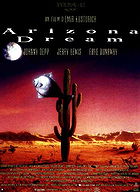 Posted : 17 years, 1 month ago on 18 May 2008 10:32
(A review of Arizona Dream)
Posted : 17 years, 1 month ago on 18 May 2008 10:32
(A review of Arizona Dream) 0 comments, Reply to this entry
0 comments, Reply to this entry
Woody Allen's best film!
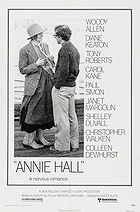 Posted : 17 years, 1 month ago on 18 May 2008 08:17
(A review of Annie Hall)
Posted : 17 years, 1 month ago on 18 May 2008 08:17
(A review of Annie Hall)
The world is ostensibly divided into two categories - those who adore Woody Allen films and those who abhor the works of Woody Allen. As I have viewed very few of Woody's movies I cannot be consigned into any of these categories. Nevertheless your enjoyment of each Woody Allen film is determined by your perspective on the guy's approach to filmmaking.
Annie Hall was recognised by the Academy Awards when it copped four Oscars including Best Picture, Best Actress and Best Director. Extensively regarded as his greatest motion picture, Woody Allen's Annie Hall is partially an autobiographical anecdote abundant in adult themes and perceptions on the topic of relationships. These themes are ornately delved into during the film's moderately diminutive running time. We see the ups and downs of relationships, as well as the break-ups succeeded by being reunited.
The foundation of the film is of Woody Allen's real life relationship with Diane Keaton. Woody Allen portrays a Jewish comedian named Alvy Singer, with Diane Keaton playing a nightclub singer named Annie Hall. The film broadly traces the relationship between the two of them over an extensive period of time. As the customary relationship dilemmas begin to foster, they progressively pull away from each other and realise that it will never work between them. The opening monologue from Woody Allen brings the viewer up to date with the state of affairs: that he and Annie have broken up and he's distraught about it.
The purpose of the flashbacks is to explore the reason behind their eventual break up. What went wrong? When did it happen? How could it have been avoided? This film is poignant and brilliant because the audience can develop their own perspective on where he actually did go wrong. As the protagonist's interactions seem to be normal, it's hard to realise the point when the two realise that it could never work. They fight and have their evident divergences; hence incredibly true to life as we also explore other themes of a relationship. This mainly includes jealousy and infidelity. It even investigates the awkwardness of being with another partner. These underlying themes and messages are fascinating. Personally I thought that it made for great entertainment.
Annie Hall is marketed not only as a romance but also as a comedy. There are several good laughs in the film that are just funny because they are true (like a girl calling someone over at 3am just to kill a spider that is causing them to lose sleep). In other instances it's Woody Allen's impeccably delivered monologues as a stand up comedian, or even just flashbacks when we can just laugh at the pathetic nature of an individual (like an actor inserting laughter into a sitcom to make it seem funny).
Annie Hall also boasts an enormous array of fantastic performances. Woody Allen is very cute in the title role (that is essentially himself); however in each film he always seems largely the same. There are several notable instances when Woody talks to the audience about a certain situation. Diana Keaton has an astronomically appealing screen persona. While she plays opposite an anxious, stuttering Woody Allen it's usually hilariously funny. This film also features a number of interesting cameos from actors who went on to become very famous. When this film was made they were not big names in Hollywood. Examples include a 30-second scene with Christopher Walken and a brief shot featuring Jeff Goldblum. In a historical sense this is very fascinating. Their scenes are also quite memorable. It's almost as if Woody knew that they would become big stars later in their lives.
Annie Hall is a clever, charming romantic comedy that is thoughtful and original. Its style in particular is very impressive despite a number of dated filmmaking techniques. Okay, so the film explores themes that are palpable in everyday society. I just find it interesting in a poignant "funny because it's true" sense. Highly recommended.
 0 comments, Reply to this entry
0 comments, Reply to this entry
Hilarious dark comedy!
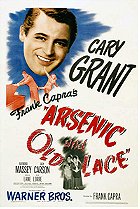 Posted : 17 years, 1 month ago on 17 May 2008 11:51
(A review of Arsenic and Old Lace)
Posted : 17 years, 1 month ago on 17 May 2008 11:51
(A review of Arsenic and Old Lace)
Arsenic and Old Lace is a film for individuals who enjoy the absurd dark comedy genre. This film is indeed a number of decades old and consequently ruthlessly disregarded. Notwithstanding its age you'll be hard-pressed to find a superior dark comedy that can match the genius of this: Frank Capra's 1944 film.
Over 60 years on and this film is still one of history's greatest comedies. From its opening sequence until the closing titles it's simply impossible to feel bored in amidst the sparkling performances and the fast-paced string of events that incessantly unfold.
Based on a hit Broadway play by Joseph Kesselring, this frenetic black comedy follows the central character Mortimer Brewster (Grant); a dramatic critic and an established bachelor. He has spent his career criticising marriage and making points about its futility...even in book form! As the film opens he is getting married to a woman named Elaine (Lane) which stirs a media frenzy. On his wedding day he learns that his two sweet aunts Abby (Hull) and Martha (Adair) have found a way to improve the lives of elderly people living in isolation without family or friends - by poisoning them! But they are both extremely nonchalant and calm about the situation: they have no problem with killing them and burying them in the cellar, nurturing the graves every week. On top of this, Mortimer's Uncle Teddy (Alexander) believes that he is in fact President Theodore Roosevelt. As Mortimer is still trying to come to terms with finding a way to prevent his crazy aunts from killing more people he also tries to get Uncle Teddy into a quality mental institution, tend to his new bride, keep a taxi driver waiting (for several hours), help a new police officer write a play and now also deal with the sudden reappearance of his insane brother Jonathan (Massey) with his personal plastic surgeon Dr. Einstein (Lorre).
Arsenic and Old Lace is a beautifully conceived story that is handled wonderfully and is highlighted by the eccentric performances from everyone in the cast. Cary Grant is delightful in this form of humour. He is certainly a scene stealer for every second of his screen time. Grant's characterisation of an intriguing character is magnificent and enthralling. It's classic comedic genius as Grant tries his hardest to get out of the trickiest of situations. Credit must go to the screenwriter for developing the role perfectly suitable for Cary Grant to play. This could be his best performance to date!
There's also an assortment of whacky co-stars who play their roles to perfection. Naturally, I must also mention the superb direction from Frank Capra. I cannot fault the composition of any scene in the film. Heck, even the opening title cards were enough to have me laughing uncontrollably. The rest of the film is thankfully graced with such genius.
Arsenic and Old Lace is strictly for those who enjoy morbid humour. This film is the essential production from the works of Frank Capra. During his career he produced so many fantastic films like Mr. Smith Goes to Washington and It's a Wonderful Life. You don't need to be a fan of the director to enjoy his work because of the versatile appeal. This is absurd dark comedy at its very best!
The film takes off at lightning pace: after the opening at the marriage license agency, the film is then the story of the events that occur on a single night. With so much great humour, witty dialogue and interesting characters you will find it irresistibly tempting. It's over-the-top and cartoonish, but its faultless composition makes it very simple to suspend disbelief. Arsenic and Old Lace is light-hearted fun and still a classic romp to this very day.
 0 comments, Reply to this entry
0 comments, Reply to this entry
Solid World War II action thriller!
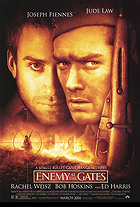 Posted : 17 years, 1 month ago on 16 May 2008 01:40
(A review of Enemy at the Gates)
Posted : 17 years, 1 month ago on 16 May 2008 01:40
(A review of Enemy at the Gates)
Over the years, movie studios have incessantly produced large scale World War II films that portray a certain part of the long-running war. Enemy of the Gates is one of the latest action thrillers to be produced during Hollywood's recent obsession with war films.
Essentially this film is another attempt at equalling the best war film of all time - Steven Spielberg's Saving Private Ryan. With this style of violence and epic battle sequences in mind, this film tackles the battle of Stalingrad and its aftermath.
The Germans are conquering virtually all of Europe and are close to crushing the Soviets. They only need to take control of Stalingrad to complete their plan. Based on an actual historical character, an accurate Russian rifleman named Vassili Zaitsev (Law) emerges as a prominent figure in the army after an act of heroism during the battle of Stalingrad of which he was one of the only Russians to survive. Vassili is an extraordinary marksman who gained quite a reputation during the war. His friend Commisar Danilov (Fiennes) endlessly prints stories about him; praising his skills and intelligence while in combat. The Germans are losing sleep over Vassili's extraordinary skill with a rifle. Because so many men have been lost thanks to a bullet from his rifle, the Germans send in a professional sniper (Harris) to match the skills of Vassili. Soon a sickeningly embarrassing love triangle emerges between Vassili, Danilov and a woman named Tania Chernova (Weisz).
Enemy at the Gates opens with a bang. Its retelling of the battle of Stalingrad is guaranteed to please history enthusiasts, former soldiers and the action junkies. Like the opening sequence of Saving Private Ryan, this battle is shown with a high level of realism and gruesome violence. But after these solid opening 25 minutes the film then falls victim to the typical war film syndrome. The whole thing is a solid action thriller with a lot of intensity and breathtaking set design. It succeeds in delivering realism to its source material. It's an incredible shame that the screenwriter had to spoil the whole thing with such a ludicrous romance sub-plot. As soon as an attractive young woman appeared on screen, it was foreseeable that a host of characters would want to get involved with her.
Aside from this endless assortment of clichés and conventions, the film's dialogue isn't much better. I thought that the dialogue sounded unnatural and contrived. Not to mention the blatantly distracting and disconcerting fact that while the Russians write and type in their natural language, they put together a sentence and deliver announcements over radio...while fluent in English! The German soldiers can also speak perfect English. The irony is in the recruiting of translators to translate the German messages. If they keep speaking English, why would a translator be necessary?
The powerhouse performances are among one of the film's redeeming features. But yet again blatant factual errors hurt the film's entertainment value. None of the actors appear to make an effort to produce an accent while delivering dialogue. Jude Law is a great actor for sure. However it looks strange and stupid because he plays a Russian who speaks English in an English accent. At points in the film while no lines are being said and instead facial expressions tell the story...now that's when the performances are first-rate.
Enemy at the Gates also contains some superb production values. The expansive locations look authentic and true to life. As planes fly over we can feel the impact and the palpable fear that the protagonists are exhibiting. The film cleverly tells a nail biting game of cat-and-mouse between two snipers in the battlefield of Stalingrad.
Like all recent war movies the costumes look authentic, the make-up looks superb, cinematography is great, directing is strong and there's a triumphant score as the bow on top. Enemy at the Gates was made with the audience in mind that will enjoy mindless violence as opposed to intelligent dialogue.
 0 comments, Reply to this entry
0 comments, Reply to this entry
Treasure chest of nostalgia.
 Posted : 17 years, 1 month ago on 16 May 2008 08:49
(A review of American Graffiti)
Posted : 17 years, 1 month ago on 16 May 2008 08:49
(A review of American Graffiti)
All and sundry can recollect a teen flick that reflects accuracy in its depiction of the existing teen generation. American Graffiti was made during the 1970s but was set in the 1960s as we scrutinize the lives of the youths from the period. When this film was initially released George Lucas hadn't yet made a name for himself. For those of you familiar with Star Wars you will never recognise that this is actually George Lucas grasping the reigns.
Although American Graffiti was made several decades ago, very little of its influence and poignancy has degenerated. In fact this is still one of the greatest teen films ever made. Even if filmmakers used contemporary technology and was given a large budget, nothing would come close to the atmosphere or the accuracy of George Lucas' classic film gem. With this film Lucas proved that he was able to create an outstanding film on time and on budget (the film costed exactly $777,777.77 to make).
American Graffiti was released with the tagline "Where were you in '62?" and, logically enough, is set in 1962. This year was on the eve of the loss of American innocence - marginally preceding Kennedy's assassination and the Vietnam War. The focal characters of this comedy/drama movie are a group of high school graduates who spend their last night in town before heading off to college in the morning. We follow their exploits throughout the entire night as they cruise around town while listening to popular radio personality Wolfman Jack.
In creating American Graffiti Lucas learned a number of valuable lessons about filmmaking that proved useful when he went on to create the Star Wars movies several years later. Star Wars fans should be grateful of this film's existence.
With this film, Lucas has created the essential addition to the coming-of-age genre. These teenagers have to overcome hindrances to accomplish the shared objective of reaching adulthood. They cope with the predestined bereavement of innocence and their apprehension towards change. American Graffiti is not only a wonderful piece of entertainment even in this era of cinema, but it also marks a historical milestone in filmmaking and one of the most accurate non-Hollywood portrayals of the era it is representing.
The film also launched the careers of several people; Harrison Ford's acting career, Ron Howard's acting + directing career, Richard Dreyfuss' acting career, and of course George Lucas' versatile career in the industry. The central characters of this film are filled by Ron Howard and Richard Dreyfuss. This was far before any of them become famous and much-loved actors.
Because it has been several decades after American Graffiti first hit cinemas people always wonder what the appeal is for this classic. To address this query you can only watch the film. Honestly, you cannot describe the film's appeal using words. Needless to say it's an enthralling film with interesting characters and an intriguing plot.
It's a landmark in cinema and catapulted those involved to almost immediate stardom. Within the script you'll find outstanding humour, clever dialogue, hilarious situations and a suitable 1960s setting.
George Lucas purposely used a number of outtakes (including fluffed lines and actions done incorrectly) to create more of a realistic effect...and of course for the sake of an on-set laugh. American Graffiti embodies all the qualities of life as a teenager during the '60s. This doesn't focus on the parties, drugs and alcohol: instead it's a story about the fun that teenagers can have with a set of wheels and some interesting people. This is truly one of the most important films in cinematic history. Followed by More American Graffiti.
 0 comments, Reply to this entry
0 comments, Reply to this entry
Typical aging Stallone.
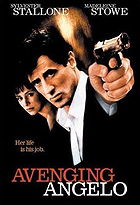 Posted : 17 years, 1 month ago on 16 May 2008 07:52
(A review of Avenging Angelo)
Posted : 17 years, 1 month ago on 16 May 2008 07:52
(A review of Avenging Angelo)
Let's admit it: whenever you observe a poster or the cover of a DVD that flaunts Sylvester Stallone brandishing a firearm you'll discern that the film will at least be entertaining. Avenging Angelo is an unforeseen twist on Stallone's conformist tough guy persona. As an alternative he is sweeter and more appealing in this romantic action comedy.
Stallone portrays long-time bodyguard Frankie Delano who has squandered his entire career working for an Italian mob boss named Angelo (Quinn, for whom the film is dedicated to). Frankie has been delegated by Angelo to watch over long lost daughter Jennifer (Stowe). Even after a number of years Jennifer has no idea that she is Angelo's offspring as it would endanger her life due to Italian assassins who endeavour to eliminate them both. As the film's title would suggest, Angelo is eventually whacked by the mob. Frankie pays a visit to Jennifer to divulge the truth: that Angelo is her true father. Owing to recent personal nuisances, Jennifer isn't intensely receptive towards any other people entering her life; let alone being informed of the deplorable truth concerning her recently-deceased real father. Subsequent to Jennifer eventually acknowledging her true heritage she teams up with Frankie to avenge the death of her father.
Like a great number of Stallone's recent action vehicles, the film met with negativity from both the critics and audiences. The Razzie committee always take advantage of the latest action film featuring an aging Stallone (They didn't pick on him this time, surprisingly. They still pick on him frequently though). In my opinion I believe that Stallone did a surprisingly good job with this role. His dialogue is understandable for about 70% of the time, and his character's life doesn't revolve solely around firearms.
Stallone was in his late 50s when this film entered production. It's great to see that he still has the charm and charisma we came to love and expect ever since Stallone graced the silver screen with Rocky. If you're a die-hard fan of only a mindless Stallone action vehicle then this would not be one to watch. Avenging Angelo is the furthest thing from a simple straightforward action film. In the place of frequent action we have a sickening love story, predictable sub-plots and a few clichéd close combat scenes. I prefer the days of Rambo and Cobra. Madeleine Stowe has a subtle screen charm. Naturally, her role is swimming in typical character clichés.
Avenging Angelo tries to be both a romantic comedy and a crime film mixed with elements of an action movie. But the film never finds a rational comic tune; instead stuck with a screenplay that makes little sense and appears to move from silly plot point A to even sillier plot point B. The dialogue throughout the movie is laughably atrocious. I mean sure, the cast is decent and the filmmaking is solid. However I thought that without a good or decent screenplay then a film will be an embarrassing turd. In spite of a promising build up throughout the first half, it bogs throughout its middle section and its conclusion is incredibly conventional. I basically predicted the ending within the first 10 minutes.
Avenging Angelo took tonnes of criticism with good reasoning. I am an enormous fan of Sylvester Stallone and his new guise is at least unique; however the man needs to make some better career moves. Instead of starring in silly low profile rubbish he needs to look past the money and try to find quality in a screenplay while choosing them. His soft touch here is appealing, but ultimately let down by the dopey screenplay and a terribly foreseeable string of events.
 0 comments, Reply to this entry
0 comments, Reply to this entry
Entertaining but bland.
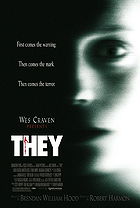 Posted : 17 years, 1 month ago on 15 May 2008 06:55
(A review of They)
Posted : 17 years, 1 month ago on 15 May 2008 06:55
(A review of They)
The horror genre is comfortably separated into two different categories. The first is of course the mindless, gory horror fest when the objective is not to scare the audience but fill the screen with far too much disturbing gore. The second category is the horror film low on violence and gore. Instead this is replaced with spine-chilling moments and effective thrills. When done properly, both categories can produce some good work. They is certainly part of the latter. Toned down to a PG-13 rating in America; this film is not for those who crave gory horror films such as Friday the 13th or Nightmare on Elm Street.
While They had an interesting premise that plays on the genuinely recognisable human fear of the dark it was ultimately a bland and predictable entry to the horror genre.
After an opening sequence that effectively sets the tone for the film, we are then introduced to a graduate student of psychology named Julia Lund (Regan) who is currently studying for her masters. She is pulled into the psychological problem of her childhood friend Billy (Abrahams) who endlessly drones on about staying in the light and how "they" are out to get the both of them. Naturally at first Julia believes that this is mindless ranting without any fact. It's only after one of Billy's worst episodes that she finally realises that Billy might not be totally insane. As the arachnid demons living in the dark get more persistent, Julia begins to talk to some of Billy's friends as they attempt to find a way around their seemingly inevitable fate.
The premise of They is an expansion on the typical childhood fear of the dark. Every child goes through the phase of being terrified of the dark. The creatures in this film can only attack in the dark and when no-one else is around. Of course, kids watching this will probably never sleep again. There are a number of genuinely spine-chilling moments throughout the film. Even more surprisingly is that the film is actually scary at times. If you watch it in a dark room with the lights out on a rainy night, be prepared for one pretty terrifying experience.
For a tame, watered-down horror film it's a necessity that the film must carry some solid filmmaking. I have no complaints about the directing or the cinematography. Unfortunately some of the scares might also trigger a bit of laughter due to some awkward framing.
I had my reservations about the cast. Complaints were limited when it came to Laura Regan in the leading role. Her fear and motivations are palpable during the more intense horror scenes. On the contrary there are several instances when more acting is required. She also looks a bit too cute, even when she's meant to look terrified. This is another case of Hollywood choosing an attractive actress as opposed to an actress that perfectly suits the part.
They is cheesy; however its atmosphere is solid and scary. There are plenty of opportunities for the audience to be at the mercy of the filmmakers; not knowing what will happen next but aware that a scare is about to occur. Some of the scares are predictable albeit still quite chilling at times. Whenever the lights are terminated and the shot darkens we know that something terrifying is about to happen.
One of the film's flaws is in its gross predictability. At least 60% of the scares can be predicted before they occur. The film is slightly uplifted by its unconventional ending. It's extremely clever to stay away from the clichés when it comes to horror. Although the conclusion is slightly unsatisfying, at least the filmmakers weren't afraid to stay away from the genre clichés.
They is a decent entry to the horror genre. It's far from brilliant but the pasting it took was grossly unnecessary. For me the film was atmospheric and scary despite being corny and predictable. Worth seeing. "Presented" by Wes Craven.
 0 comments, Reply to this entry
0 comments, Reply to this entry
Not bad. Not great, either.
 Posted : 17 years, 1 month ago on 14 May 2008 12:58
(A review of Dickie Roberts: Former Child Star)
Posted : 17 years, 1 month ago on 14 May 2008 12:58
(A review of Dickie Roberts: Former Child Star)
Dickie Roberts: Former Child Star is a film that was severely panned by critics and audiences upon first release. It met with such an appalling reception that I purposely avoided it in fear of it being as horrible as some people have said. However when I finally watched the film all my previous expectations were surpassed. People called it 'poor' and 'laugh-less' but I guess it's a matter of taste: I laughed quite frequently and found it to be decent comedy.
Dickie Roberts (Spade) was a very popular child actor who had an enormous fan base. After his show was cancelled while still a young child, the 'child actor syndrome' kicks in: i.e. Dickie is no longer a desired actor among the studios. He slips off the grid and out of the industry due to his sudden drop in popularity. Even his mother leaves him while he is still at a young age. Now an adult, Dickie is poor and has been reduced to typical jobs such as being a valet attendant who parks cars. He misses the fame and popularity of being a famous actor. When in Hollywood he meets Brendan Fraser (played by himself, logically enough) who is able to get Dickie an audition for the new Rob Reiner film. But Dickie is rejected because he doesn't have the genuine feel of the part due to his childhood that he was robbed of. Reiner believes that Dickie just isn't a real person because of the way stardom affected him when he was a child. Dickie is still determined to get the part and stage a successful comeback. To do this he will need to develop a personality of his own. So he advertises a considerable amount of money if a family will allow him to move in and hopefully relive a proper childhood. Dickie moves in with the typical suburban family: selfless mother Grace (McCormack), selfish father George (Bierko) and their two kids Sam (Terra) and Sally (Boyd).
There is a good basic premise here. It's a well-known fact that child stars usually disappear from the spotlight or their life is lost to drugs and alcohol. Although the script is decent, it's ultimately flawed massively by its overuse of clichés and conventions. Not to mention a few sickening sub-plots like the predictable one concerning Dickie falling in love with his new mother Grace. There's quite a bit of sexual humour trapped within this solitary sub-plot. And then of course we have the obligatory few scenes concerning school bullies that Dickie swiftly takes care of. These are all predictable and it wouldn't be a tragedy if they were left out. Despite this they're still mildly amusing at times.
The central laughs are built on the clever dialogue deliveries from David Spade. I'm not going to tell a lie at all - I thought that some of his insulting rants were absolutely hilarious and I was laughing out loud quite constantly. But it's a shame there wasn't any effort on the part of the screenwriter (looking at you, David Spade) to create any other gags or any other characters that can deliver funny dialogue.
After the first third of this film, we all know what the outcome will be. The conclusion is cheesy and predictable beyond words. The good news is that there are a number of decent laughs to keep one entertained despite its predictability.
David Spade is funny when given the right material to work with. Using a script he wrote himself it seems he gave his character the majority of the funny dialogue. The rest of the acting is okay but nothing groundbreaking. The kids sometimes seemed a little cardboard, as did the rest of the cast at times. Acting lessons are badly required during some sections of the movie.
Aside from its flaws and shortcomings, Dickie Roberts: Former Child Star at least stocks a good supply of laughs. There's no brilliance or innovation in the laughs department; however the film is still hilarious viewing. One of the film's highlights: a reunion of genuine former child stars being grouped together for a musical finale during the end credits.
 0 comments, Reply to this entry
0 comments, Reply to this entry
A waste of celluloid.
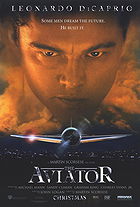 Posted : 17 years, 1 month ago on 14 May 2008 05:18
(A review of The Aviator)
Posted : 17 years, 1 month ago on 14 May 2008 05:18
(A review of The Aviator)
Martin Scorsese established himself as one of the best directors in Hollywood. With each new movie the crazed Scorsese fanatics praise the movie like it's the second coming.
When I watched The Aviator I was never a fan or hater of Scorsese. I am fond of some of his movies for sure. GoodFellas in particular is still a superb piece of movie-making. I had heard so much appraisal of The Aviator and decided that it was time for me to see what the ruckus is about. Unfortunately my viewing concluded with feeling of dissatisfaction and boredom.
This biopic of eccentric rich lunatic Howard Hughes is 3 hours of complete and utter monotony! After about the first half an hour I was already tempted to drift off to sleep. But I kept telling myself that there must be something interesting about to occur. Nothing interesting or engaging ever did occur. When the film ended I was glad that I could finally roll over and go to sleep. I watched this film with my parents. We sometimes have conflicting views on the quality of a movie. With this film we all agreed strongly that The Aviator is pointless and extraordinarily boring! In my opinion I can't see anyone being interested unless they're a specialist in aviation.
Leonardo DiCaprio plays Howard Hughes as the film chronicles his life during the 1940s. As the film opens he's in the middle of making a movie called Hell's Angels. That's the only interesting part of the movie. I thought that the first half an hour was quite captivating. The filmmaking process had me interested because it had an interesting story to tell. But from there everything went downhill; I didn't see any evidence of a plot, I never found anything at all interesting.
The Aviator is stretched out beyond all belief, dull and devoid of any life. DiCaprio is tragically distracting in the title role. He has done some mediocre work in the past, and some good work. We can add this film to his list of mediocre performances. Everything seemed so forced and contrived. He tries but modestly fails. That's the bottom line. Cate Blanchett, on the other hand, was truly magnificent in her role. It's just such a shame she disappears after the first half. Blanchett was understandably presented with an Oscar. She was flawless. Maybe if Scorsese used her properly she could have saved the film.
The screenplay must have weighed a tonne. It's loads and loads of dialogue lacking any emotional spine. This makes the film seem very shallow, disingenuous and cursory.
I thought that the cinematography and the special effects looked fantastic. I was disappointed with the limited opportunities to showcase such breathtaking cinematography. It seems that there was potential in every aspect of the filmmaking; it's just that Scorsese under-uses all his solid resources.
The Aviator had everything going for it - it's a biopic of an extraordinary man with a good cast and a great director. But it is not in the least bit entertaining or interesting. This is another classic case of focusing on aspects of the story rather than the entertainment value for the viewer. Leave this one on the shelf...for your own good and well-being. Overrated, over-hyped, long, convoluted and incredibly boring. The Aviator will put you to sleep. (People who suffer from insomnia...go buy it!)
 0 comments, Reply to this entry
0 comments, Reply to this entry
An astounding drama!
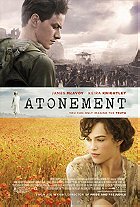 Posted : 17 years, 1 month ago on 14 May 2008 05:01
(A review of Atonement)
Posted : 17 years, 1 month ago on 14 May 2008 05:01
(A review of Atonement)It is indeed an extremely rare event that a masterpiece like Atonement comes along. After a tedious wave of mediocre films and straightforward blockbusters throughout the year, Atonement is an extremely good and effective war drama that ended up being one of the finest films of 2007.
I had wanted to see this production because of the critical acclaim it received and its successful trip to the Golden Globes (during which it walked away with Best Motion Picture for Drama; beating other films like No Country for Old Men that were heavily favoured). After seeing the trailer only minor interest was sparked in my mind. On a recommendation I approached this film, and ended up leaving the cinema completely speechless.
It's an unfortunate fact that films of this stature are few and far between. In the course of a year only a very limited amount of films can be found of such quality in the case of contemporary cinema.
Like many other people have stated, it is a fact that the plot cannot be revealed in any depth. The brilliance of the movie is the audience's inability to predict what is going to happen next. If you ruin one part then the impact of the movie will be slightly lessoned. The story is gradually built up throughout the film's running time. With each new scene the story continues to unfold and expand.
The first half of the movie is a compelling drama set within the confines of a mansion. Cecilia Tallis (Knightley) lives with her family and is in love with a man named Robbie (McAvoy). Cecilia's snobby, jealous little sister Briony (Ronan) is unable to completely understand the concept of love and hence cannot precisely comprehend the sneaky relationship that Robbie and Cecilia share. The second half of the movie unfolds because of a significant event that happens towards the end of its preceding half when a man is wrongly convicted of a crime he did not commit. Because of a lie one of the characters told, the lives of several people are irrevocably altered. The film is then a powerful war drama set during World War II that follows a host of different characters living their lives after the tragedy that previous transpired.
Atonement is a breathtaking, emotional tale that asks patience from its audience. At first the film is slow-paced but captivating. The drama that occurs throughout the movie grasps your attention. If you appreciate fine filmmaking in lieu of blockbuster rubbish then you will find it impossible to feel bored.
The film's brilliance can also be attributed to its realistic atmosphere that is especially well established by the performances. We have never seen Keira Knightley in a role like this before. I usually find her performances cardboard and lacking any emotional depth. She briskly breaks out of her acting confines; instead becoming both realistic and breathtaking. It's impossible to fault her portrayal. James McAvoy is remarkable as well. There are a number of scenes when no words can describe how powerful his depiction is. I must also mention young Saoirse Ronan. She wouldn't have been any older than 12 or 13 when the cameras rolled. It's rare to compliment an actress so young whose career has barely even started. Ronan is exceptional!
The direction by Joe Wright was also extraordinary and brings the script to life with excellent results. I felt that the storytelling was unique and memorable; and I will admit being confused by the frequent change of setting. Like the rest of the filmmaking aspects, this is extremely unique. The film's pacing varies; however for the most part the acting is so focused that the film doesn't feel so long.
When the credits rolled I sat speechless; entirely satisfied with the film I had just exhibited. The tragic part was that those around me did not seem to share my sentiments because of its uniqueness. I'm not going to lie to you: the film is not for those who seek entertaining blockbusters. It's strictly for those who look past the entertainment value and examine it for what it is: an exquisite masterpiece. Atonement is beautiful, memorable, poignant, emotional and unique. It's a film that is well told with an inspiring script adapted from the novel by Ian McEwan.
 0 comments, Reply to this entry
0 comments, Reply to this entry
 Login
Login
 Home
Home 183 Lists
183 Lists 1671 Reviews
1671 Reviews Collections
Collections